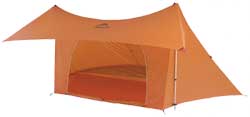Lightweight Thoughts – Shelter System
This the first part of my Lightweight Thoughts series, where I’ll be examining my hiking gear and considering way to improve its weight and improvement.
Current Shelter System
My current shelter arrangement is composed of the Mountain Science Research (MSR) Missing Link tent and a tyvek ground cloth I cut from a sheet of industrial tyvek. The MSR Missing Link is meant to be a two-person tent, but I run on the tall side and I also like the extra space for mobility and keeping my gear near me and out of the elements. The Missing Link has no poles, but instead uses two trekking poles (10oz each) as its main supports. This feature keeps the weight down to 3lbs (48oz) which is remarkable for a three-season, two-person tent. On the downside, it is not free-standing and needs to be staked out; an affair that can take a bit of time and a site that is accommodating to this sort of hiking. Also, the walls are single-layer which can lead to some condensation issues, but this is the case with nearly all of the lightweight tents. The tyvek ground cloth might be overkill in some terrains, but I’d much rather replace a $15 sheet of it than the flooring of an expensive tent.

Total Cost: $265.00 (not adjusted for the time I’ve owned it)
Total Weight: 52oz
(excluding 2 trekking poles, includes ground cloth)
Shelter System #1
Tarp Tent systems offers two models that I’ll be looking at here. Their name is a bit misleading, since several of their products are far more than a “tarp”. The first is the Contrail. This 1+ ultralight tent weighs in at 24.5oz and features flooring (something often missing from ultralight configurations). Like the MSR Missing Link, the Contrail using no dedicated poles, but a single trekking pole (10oz) to set up, which is nice because I generally only carry a second trekking pole for setting up the Missing Link. Also like the Missing Link, the Contrail is not free-standing (needs to be staked out) and is single-walled. I would be inclined to use a ground cloth for the same reasons I mentioned under the Missing Link.


Total Cost: $214.00
Total Weight: 28oz
(excluding 1 trekking pole, including ground cloth)
Shelter System #2
Another product I looked at also comes from Tarp Tent and is called the Rainbow. This snug 2 person (or spacious 1 person) tent weighs in at 32oz and uses two trekking poles (10oz each) like my existing MSR Missing Link and the Contrail above. Its advantages over both the Contrail and Missing Link is that it can be set up free standing very quickly; only need staking out under windy conditions. Like all the shelter systems I’ve mentioned so far, it has full flooring and bug netting. In all these regards, the Rainbow is a feels to me like a compromise between the Missing Link and the Contrail.


Total Cost: $230.00
Total Weight: 35.5oz
(excluding 2 trekking pole, including ground cloth)
Shelter System #3
My final shelter system consideration is actually a composite of several solutions and a big departure from the three systems above. It was inspired by some of the rigs Implementor and legions of ultralight hikers have employed. I’ve kept mine a bit more robust than those minimalist arrangements in keeping with my Mission Statement, but I think I have still come up with a surprisingly good option. This solution involves a true tarp, ground cloth, bivy bag and bug netting. While not as all inclusive as the three systems above, this system is very light, allows for customizing (modular) in the field and still competitively priced as well. On the downside, its more exposed (in principle) and may require more finesse to deploy. The components are: an A16 Bug Bivy (6oz), ground cloth (3.5oz), Montbell Breeze Dry-Tec U.L. Bivy Sack (6.5oz) and Integral Designs 5’x8′ “Sil Tarp” (7oz). An optional configuration I’ve considered replaces the Integral Designs “Sil Tarp” with a same size Integral Designs “Sil Poncho” (10oz) which can do double duty as a trail poncho as well as shelter. While several hikers go without the bug bivy and the bag bivy altogether, I prefer the additional protection from pests and rain spray. Optimally this design uses one trekking pole (10oz).


Total Cost: $230.00 ($235.00 for poncho version)
Total Weight: 23oz (26oz for poncho version)
(excluding 1 trekking pole, including ground cloth)





















These are my thoughts on the various choices:
The Tarp Tents are very lightweight, and do work well, but they aren’t anywhere near as durable as the current system you have (MSR Missing Link, tyvek ground cloth, hiking poles). While they are very well made, with top-of-the-line materials, they aren’t going to be anywhere near as durable as the Missing Link. I look at these kind of tarptents as “backup systems”, as they’re primarily used by thru-hikers and section hikers on established trails like the AT, where they’re mostly staying in shelters, but they want to have a fully-functional backup in case they can’t stay in a shelter. So, because this is essentially limited-use gear, they try to minimize the weight impact it has on their total loadout, which means they’re wiling to put up with lesser durability because they understand that the tarptent won’t see a whole lot of use, but want it there for safety and comfort reasons. It can be used as heavier-use gear, but it’s likely that it will have to be replaced more often.
As for the 3rd option, most of the bivy sacks that I’ve seen are pretty durable, but you’re not going to have much room to move around, it’s basically a cocoon with a space over your face to allow you to breathe comfortably. I’ve used the siltarps as well from Integral designs, and while they are very lightweight, they are also pretty fragile. Mine was damaged pretty much beyond repair last time I went out because some thorn bushes blew onto it. There are more durable options in tarps, though, without adding a whole lot of weight, like some of the nylon tarps (which are made of a material similar to what the Missing Link is made from).
Personally, I’m looking to pick up an MSR Missing Link soon, because it’s such a robust design, it offers a lot of room, and it’s the best weight/durability compromise that I’ve seen. Lightweight gear is always a compromise, but that’s the best compromise I’ve seen.
I was really hoping to lose some weight in the area of shelters. I’m not entirely sure about the Tarp Tent durability, but they appear to use the same grade silicon impregnated nylon that is used in the Missing Link (1.1-ounce/yd grade).
I find it ironic that you’re moving towards my original shelter solution FROM tarp designs, while I’m considering moving in the other direction; towards the solutions you used to prefer. 🙂
With me, it’s just realizing that given my particular pack and my weight and size, I can carry a bit more weight without sacrificing carrying comfort, and one area where I feel that my comfort could be significantly increased is in the area of shelters. The hammock idea really didn’t work out well for me (because of my size, they work much better for smaller folks), and I’ve determined that I need a fully-enclosed shelter (no more salamanders crawling on my face in the middle of the night!), and I’ve really been looking and the Missing Link seems to be the best option, for me. I save weight in other areas, like my cooking gear. Like I said in my entry the other day, a lot of it is about finding what enhances your experience the most, and going with that.
I might be mistaken about the tarptents, I was under the impression that they were made from the lighter-weight silnylon. If that isn’t the case, and they are constructed as durably as the Missing Link, then that might be a good option. I’d get the ones with the floors, though, there are a lot that come without them.
Cookware is another article, but I think I may have hit rock bottom weight-wise there under my current desires/needs.
I agree completely with the flooring comment. If you have a floor-less tent, you might as well just go tarp. 🙂